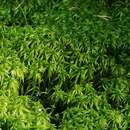Comments
provided by eFloras
Sporophytes are uncommon in Sphagnum riparium. This species is typically very easily recognized in the field with its pale green color, strong terminal bud, and unranked branch leaves.
- license
- cc-by-nc-sa-3.0
- copyright
- Missouri Botanical Garden, 4344 Shaw Boulevard, St. Louis, MO, 63110 USA
Description
provided by eFloras
Plants grayish or yellowish green, in loose tufts. Stem cortex in 2–3 layers, hyaline cells thin-walled, without fibrils and pores; central cylinder not much differentiated from cortical layers, pale yellowish green. Stem leaves 0.9–1.3 mm × 1.0–1.1 mm, triangular-ligulate or broadly ligulate, cucullate-concave, lacerate at the apex; borders rather wide on both sides, clearly widened near the base, ca. 1/3 the leaf width; hyaline cells rarely divided in the upper half, often divided in the lower half. Branches in fascicles of 4–5, with 2–3 spreading. Branch leaves 0.8–1.2 mm × 0.5–0.8 mm, ovate-lanceolate; margins strongly involute in the upper half, truncate, denticulate at the apex; hyaline cells fibrillose, with pores at the opposite ends of upper cells on the ventral surface, often with large, central pores on the dorsal surface; green cells in cross section triangular, exposed on the dorsal surface, enclosed by hyaline cells on the ventral surface. Dioicous; antheridial branches brownish. Perigonial leaves narrow at base, broader upward, abruptly pointed at the apex, borders wide. Perichaetial leaves large, elliptic, cells not dimorphous, sometimes with green cells only, hyaline cells without fibrils and pores. Sporophytes not seen.
- license
- cc-by-nc-sa-3.0
- copyright
- Missouri Botanical Garden, 4344 Shaw Boulevard, St. Louis, MO, 63110 USA
Description
provided by eFloras
Plants stiff and upright, large; green to pale green to brownish, capitulum large and flat, with a conspicuous terminal bud. Stems pale green, superficial cortex of 3-4 layers of weakly differentiated cells. Stem leaves triangular-lingulate, 1.2-1.4 mm; apex with a deep lacerate split; hyaline cells aporose, efibrillose and often septate. Branches unranked to rarely 5-ranked, branch leaves only weakly undulate, but sharply recurved at the apex, leaves not much elongated at distal end. Branch fascicles with 2 spreading and 2 pendent branches. Branch stem green, cortex enlarged with retort cells. Branch leaves ovate-lanceolate; 2-2.6 mm; straight; weakly undulate but strongly recurved, hyaline cells on convex surface with very large irregular pores (formed from the confluence of several smaller pores) at the cell apex, concave surface with large round wall thinnings in the cell angles; chlorophyllous cells triangular to trapezoidal in transverse section, apex normally slightly exposed on concave surface. Sexual condition dioicous. Spores 22-28 µm; proximal surface noticeably papillose, distal surface smooth or with fewer papillae; proximal laesura more than 0.5 the length of the radius.
- license
- cc-by-nc-sa-3.0
- copyright
- Missouri Botanical Garden, 4344 Shaw Boulevard, St. Louis, MO, 63110 USA
Distribution
provided by eFloras
Distribution: China, Japan, Russian Far East and Siberia, Europe, and North America.
- license
- cc-by-nc-sa-3.0
- copyright
- Missouri Botanical Garden, 4344 Shaw Boulevard, St. Louis, MO, 63110 USA
Habitat
provided by eFloras
Habitat: usually in open bogs, or on wet ground under coniferous forests.
- license
- cc-by-nc-sa-3.0
- copyright
- Missouri Botanical Garden, 4344 Shaw Boulevard, St. Louis, MO, 63110 USA
Synonym
provided by eFloras
Sphagnum intermedium var. riparium (Ångstr.) Braithw., Monthly Microscop. J. 13: 62. 1875. Sphagnum intermedium Hoffm. ssp. riparium (Ångstr.) Lindb., Musci Scand. 12. 1879.
- license
- cc-by-nc-sa-3.0
- copyright
- Missouri Botanical Garden, 4344 Shaw Boulevard, St. Louis, MO, 63110 USA
Comprehensive Description
provided by North American Flora
Sphagnum riparium Angstr. Oefv. Sv. Vet.-Akad Forh. 21 : 198. 1864.
Plants commonly tall and robust, green or more or less tinged with brown. Woodcylinder green; cortical cells of the stem hardly differentiated, the outer cells of the stem narrow, many times longer than wide, without pores or fibrils: stem-leaves rather large, triangular-Ungulate with a deep rent in the middle of the apex, the border formed by 4-6 rows of narrow cells with occasionally pitted walls; hyaline cells narrow, often once or twice divided, especially in the apical portion, without fibrils, the membrane on the inner surface almost entirely resorbed, on the outer surface with longitudinal membrane-pleats which pass to rents near the torn apex: branches in fascicles of 4 or 5, 2 spreading, their cortical cells in a single layer, the retort-cells with an inconspicuous neck: branch-leaves slightly undulate when dry with reflexed tips, ovate-lanceolate, strongly involute, the sharply acuminate toothed apex composed entirely of chlorophyl-cells, the border entire, of 2-5 rows of narrow cells; hyaline cells fibrillose, narrowly rhomboidal, in the basal portion 6-8 times as long as wide, shorter above, on the inner surface with irregularly rounded pores in the ends of the cells and elsewhere, mostly of nearly cell-width, less numerous toward the base of the leaf, on the outer surface toward the apex with small pores in the cell-ends and corners, 3-5 per cell, in the lower part of the leaf almost entirely confined to the ends of the cells: chlorophyll-cells trapezoidal in section with broader exposure on the outer surface, the lumen triangular; hyaline cells hardly convex on the outer surface, on the inner one fifth to one third of the diameter of the cell.
Dioicous. Antheridia in catkins on spreading branches; antheridial leaves well differentiated, brown, with fibrils and pores lacking in the hyaline cells of their basal part. Fruiting branches erect, short ; perichaetial leaves large, ovate, the apex retuse, the entire leaf composed of narrow vermicular cells with pitted walls : capsule brown, rather small, with a small operculum: spores yellow, 20-30^ in diameter, minutely granular-roughened.
Type locality: Lapland.
Distribution: Greenland; Labrador southward to the White Mountains of New Hampshire; British Columbia to Alaska; also in Europe and reported from Asia.
- bibliographic citation
- Albert LeRoy Andrews, Elizabeth Gertrude Britton, Julia Titus Emerson. 1961. SPHAGNALES-BRYALES; SPHAGNACEAE; ANDREAEACEAE, ARCHIDIACEAE, BRUCHIACEAE, DITRICHACEAE, BRYOXIPHIACEAE, SELIGERIACEAE. North American flora. vol 15(1). New York Botanical Garden, New York, NY

